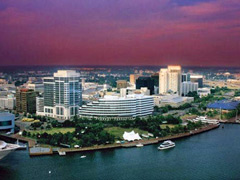Norfolk, Virginia: A Port City that Has a History of Rebirth and Hockey

The city of Norfolk is a testiment to the strength of the country. The citizens have maintained a community identity from the past through to today. Famed for their sports stadiums for basketball, baseball, hockey and now football; it is the hockey games that seem to bring attendance to see their beloved Norfolk Admirals. At any game the lights of the hockey scoreboards and the cheering fans show the city’s pride. Norfolk, Virginia started out as a port city stronghold, mainly due to its strategic location and the natural large harbor. It has been attacked, destroyed and rebuilt multiple times, because the people simply will not give up or give in.
The area currently known as Norfolk was originally part of the larger land area patroned by Adam Thoroughgood, in the 1830’s. The Norfolk area experienced a division until it was finally settled with the name it bears today. The wonderful harbor was a springboard for the construction of the first Half Moone Fort and allowed the port environment to have one of the best success rates for the export of supplies for the British Empire.
The American Revolution brought devastation to the area as the British ships destroyed almost the entire city. The stoic people of the area rebuilt their beloved city, only to have it destroyed once again in a waterfront fire. There followed a long period of political and economic problems with the migration to other areas for work. Virginia was one of the few states at the time that made an attempt at phasing out slavery, but to no avail. In the later 1800’s, Virginia became a member of the Confederate side in the Civil War, which set its course for their fate. The harbor became the place of history in the battle between the first two ironclad warships, which changed the way sea battles were held from that day forward. For the balance of the Civil War, Norfolk was under martial law by the Union side, which actually may have saved the city from further destruction. Norfolk also became a center for the escaping slaves as they set up schools to help guide their new future.
By the early 1900’s it was decided to establish a U.S. Naval Base at Norfolk, which was then the largest ever built. The area experienced a growth of infrastructure, mainly due to the naval presence. The Naval Base played an integral role in all of the subsequent wars that followed in the twentieth century.
The State of Virginia was caught in the political cross-fire during the requirement for integration during the 1950’s. Virginia was against school and community integration and even went so far as to close some of their public schools down. Thankfully, time marches on and progress and enlightenment took hold in the state, however, it suffered the consequences of the late decision. Many of the residents relocated, leaving the city with the lack of funds to maintain it. The city began a decline, and it wasn’t until many years later that a process of revitalization could take place.
Today, the city of Norfolk is a shining example of history with an incredible array of art galleries, theatres, performing arts and wonderfully refurbished Tudor style neighborhoods. The harbor is breathtaking, with many maritime museums. The local passion for their sports teams has expanded from the initial baseball to encompass a rich array of choices for the sports enthusiast. Some of the most modern stadiums and fields are in Norfolk, displaying excellence in seating and comfort. The hockey scoreboards are the focus of any game as you will see when a point is scored and the cheering begins. The area has a rich and deep multicultural history and the people have proven that they simply won’t give up the city that they love so much.


